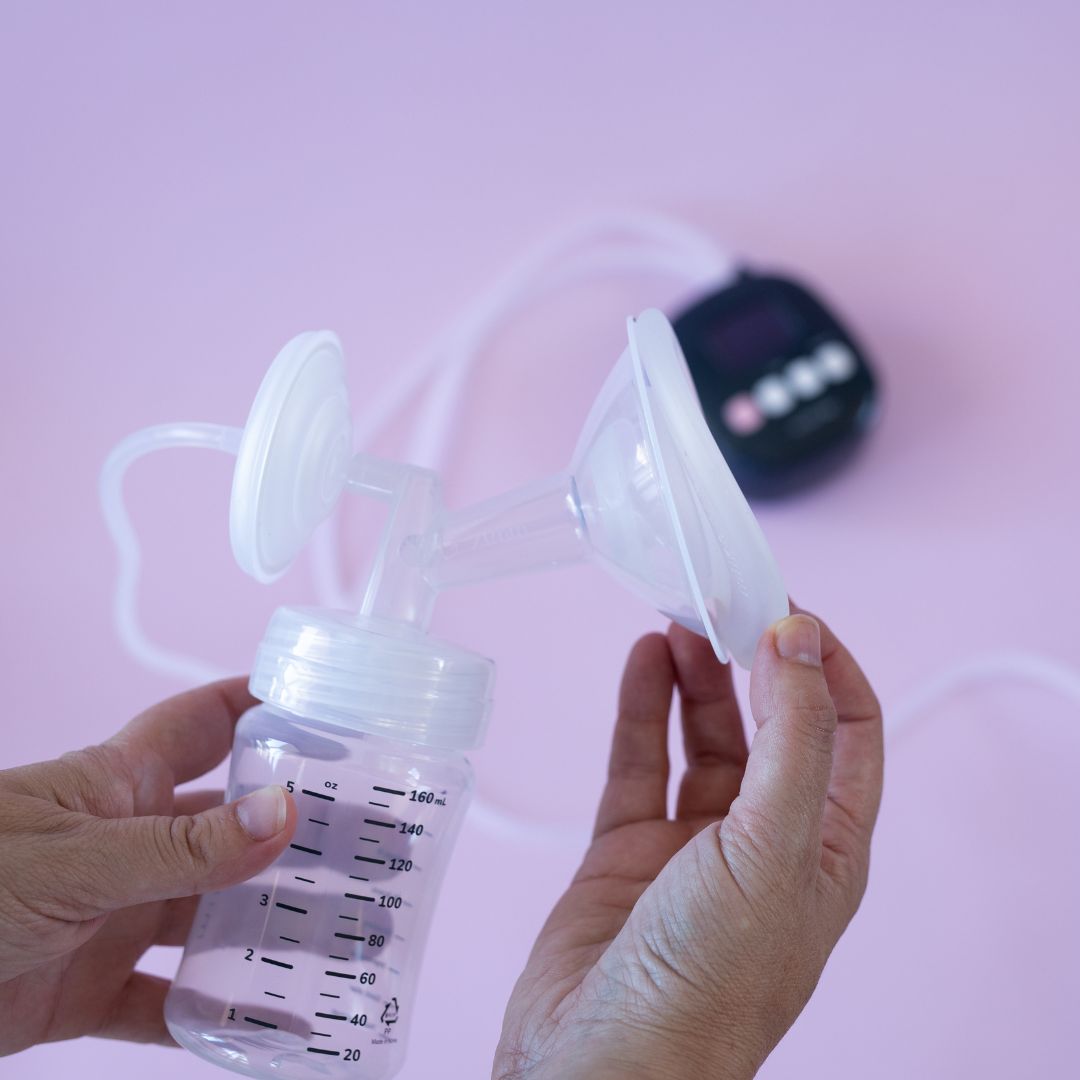Your body goes through enormous change to produce milk, especially immediately after birth as you initiate lactation and build your volume. As you settle into a feeding pattern, your baby will be the cause of the change, first by starting solids, then eventually when you wean.
In this blog, we talk about some of the key changes in your pumping journey and how and when you might adjust your base schedule.
1. Pumping to Induce Labor
We’ve put this first, because it’s the earliest point that you might start pumping. It’s also a really common question asked in forums.
In short, nipple stimulation can cause the womb to contract, possibly due to increased oxytocin. However, a review of studies looking at this recommended that it not be used in high-risk pregnancies and that more research was required to assess its safety.
Because pumping to induce labor is something that you really need medical advice and possibly even supervision for, we haven’t included a schedule for it.
2. Pumping to initiate or establish supply (newborn)
You may find yourself on a pump in the first hours or days after birth. This might be by choice or might be because you’re having trouble feeding directly at the breast.
These first few days are critical for setting up your supply, and you should work with your lactation consultant or doctor to help you through this period. You will need to be pumping often and consistently to remove milk from your breasts, which is the best way to increase your supply.
You may need to be pumping 8 to 10 times per day, for at least 15 minutes per pump, totalling 2 to 3 hours. Some clinicians advocate for even longer time (4 hours) on the pump for this period, to establish supply, or even build over-supply if you want to.
Although there doesn't seem to be research comparing outcomes for the number of pumping sessions, there is some research on comparing outcomes from the number of nursing sessions. One study compared two groups of mothers who nursed for the same amount of total time each day (137-138 minutes). They found that the group who nursed more often (10x per day) but for shorter lengths (about 14 minutes average), had babies with more weight gain at Day 15, than the group who nursed fewer sessions (7x per day) but for longer durations (about 20 minutes average). By day 30 though, there was no significant difference.
Given this is such a critical period, it is worth seeking advice from a lactation consultant to develop a schedule that works for you.
If your goal is to feed directly at the breast, rather than to exclusively pump, then this is particularly important. Some research suggests that very early use of breast pumps may affect breastfeeding rates at 6 months.
3. Pumping to maintain supply (about 3 months +)
Once your body is creating the level of milk you’re happy with, and your supply has regulated, you may start to think about dropping pumping sessions.
Again, this is a good time to speak with your lactation consultant because it can affect your supply.
You may see a change in the volumes that you express - every body and every breast is different! Take a little extra notice of your volumes when you drop a session, and adjust accordingly.
Things you can change up:
- Your session time. You may need to lengthen each pumping session. For example, at 3 months, you might drop down to 7x sessions per day. If you add a few minutes extra to each session, even though there are fewer sessions, you’d still be pumping for the same time each day.
- The particular pump session that you drop. You may find that dropping the early morning pump reduces your overall volume too much, but dropping an afternoon session pump doesn’t.
When you drop a session, you want to try to avoid any issues that you can get from not effectively removing milk from your breast. You may have heard of blocked ducts, lumps, milk stasis (stagnant milk in your ducts), inflammation or infection. Some people say they’ve had issues with these from dropping sessions abruptly. And one study from 2016 mentioned that that dropping pumping sessions (their study participant didn’t pump over a weekend), may have caused milk stasis due to irregular breast emptying.
If you like your current pumping session times, and just want to drop one session entirely without changing your whole schedule, you could just gradually reduce the time or volume that you pump over a week or two.
All of this comes with a big caveat: milk volumes are highly variable and dependent on many factors. Try to focus on whether your baby seems satisfied and is hydrated with the volumes you’re giving them after the change.
4. Pumping once baby is starting solids (5-7 months)
Once your baby starts solids, around 5-7 months (depending on where you get your advice), you may start to drop more sessions. You might find that 4x sessions per day works best for you, but that each session is quite long.
Another good time to speak with your lactation consultant.
You will know your body well by this point, and you probably will have developed tricks for really getting the most out of each session.
In the best case scenario, you can stay with this level of pumping for as long as you choose to feed breastmilk to your baby.
5. Pumping to increasing supply
You may be turning to your pump to try to increase your supply.
Your body should create more milk when you remove more milk. To remove more milk you need to either:
- increase the number of sessions you pump
- increase the time you pump each session
- make your sessions more effective at removing milk
There are studies that show that more frequent nursing (10x per day) resulted in more weight gain for babies at Day 15, than less frequent nursing (7x per day), even though the total time nursing was the same (137-138 minutes). So it may be that you choose to increase the number of sessions if you can, rather than just increase the time you pump. Again, we don't know if this translates to pumping, as opposed to nursing, so we are stuck with trial and error!
6. Power pumping
Some people feel that they can stimulate more milk by ‘Power Pumping’.
The idea is that you mimic a baby’s “cluster-feeding”, by pumping frequently over a short period of time. Again, we haven’t been able to find research supporting the effectiveness of this or any guidance on the timings, but there are plenty of comments swearing by this on the forums.
To do this, choose a 1.5 hours a day, perhaps over a week, where you can follow this routine, or something similar:
- 20 minute pump
- 20 minute rest
- 10 minute pump
- 10 minute rest
- 20 minute pump
If you’re trying to increase your supply, and you’re mixed feeding, some people suggest pumping after you have nursed.
7. Pumping to build a stash
You may like to ‘build a stash’ of milk that you can keep in your fridge or freezer.
It might give you comfort to know that there will be milk available if you get sick or need to go away. Or you might want to build in preparation for going to work or travel.
In theory, it’s simple to build a stash. You add in one or two extra pumps on top of your current schedule and watch your freezer bags grow.
In practice, it can be tricky to do it well without getting yourself into a quagmire.
How? If you build up a stash too large, you will need to use it (if you don’t want to throw it out). Every time your baby is fed thawed milk, you will either need to replace it with a pump session or expect your supply to reduce. If you are pumping to replace that thawed milk feed, then your fresh milk will need to be refrigerated or frozen. The extra thawing, cleaning, organising, and fast diminishing freezer space can take time, expense and mental load.
If you don’t pump to replace that feed (this is especially common when you return to work because you get held up), then your supply will decrease. This is fine if you wanted it to, but don’t get caught out if you don’t!
To avoid this, aim for having as few extra (1 - 2) feeds as possible stored at a time. If you’re away from your baby for work or other reasons, aim to have only as much as they’ll need until they see you next.
There is also the option to donate your milk to a local milk bank. There are usually strict requirements for this, so it's best to check ahead of time.
8. Pumping to wean
The last big change to your schedule is when you start to wean.
To do this, slowly work your way down the number of sessions per day.
Why slowly? To try to avoid any issues associated with not removing milk from your breast effectively, such as milk statis, blocked ducts, inflammation or infection.
You may wean after your baby has fully transitioned to solids. If it happens before that, then you will need to supplement your reduced breast milk with donated milk or formula.
9. Pumping to start re-lactating
It is possible to re-start breast pumping even if you have weaned.
Sometimes you may stop feeding due to sickness, or you felt you or your baby was ready. Sometimes you have second thoughts about weaning.
To re-establish lactation, you may need some medication, and you will likely need to start back on a high number of pumping sessions per day.
Seek advice from your doctor and lactation consultant. There are doctors out there who are also IBCLC certified, who would offer excellent support for this.
10. Pumping to start lactating when you haven’t been pregnant
Rather wonderfully, it isn’t necessary to be the gestational mother to your baby to breastfeed.
There are some incredible case studies of people who have successfully induced lactation. In 1999, a woman and her doctor developed a protocol for establishing milk supply in preparation for her son who was born via surrogacy. Their protocol involves taking medication from six months before the baby arrives and starting to pump six weeks before the baby arrives. The pump schedule is three-hourly for 5 to 7 minutes per side, and continues after the baby arrives. They do have an accelerated protocol.
Since it involves a few types of medication, seek advice and support from your doctor and lactation consultant. There are doctors out there who are also IBCLC certified, who would offer excellent support for this.



